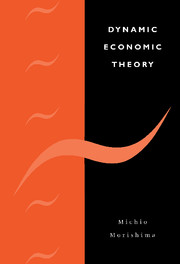Book contents
- Frontmatter
- Contents
- Preface
- 1 The method of dynamic analysis
- 2 Households' and firms' economic behaviour
- 3 Stability conditions for a temporary equilibrium: the linear case
- 4 Stability conditions for a temporary equilibrium: the non-linear case
- 5 Comparative dynamics
- Appendices
- Mathematical notes
- ADDENDUM
- Introduction
- Article I Walras' own theory of tatonnement [partly written in 1958]
- Article II Tatonnement in quantities: truncation, equilibration, growth [1956]
- Article III A contribution to the non-linear theory of the trade cycle [1958]
- Article IV Stability, oscillations and chaos
- Article V A generalization of the gross substitute system [1970]
- Article VI The laws of the working of the quasi-Frobenian system [1954, yet unpublished]
- Article VII The Cournot–Walras arbitrage, resource consuming exchange, and competitive equilibrium (with M. Majumdar) [1978]
- Article VIII The dilemma of durable goods
- References
- Index
Article IV - Stability, oscillations and chaos
Published online by Cambridge University Press: 08 February 2010
- Frontmatter
- Contents
- Preface
- 1 The method of dynamic analysis
- 2 Households' and firms' economic behaviour
- 3 Stability conditions for a temporary equilibrium: the linear case
- 4 Stability conditions for a temporary equilibrium: the non-linear case
- 5 Comparative dynamics
- Appendices
- Mathematical notes
- ADDENDUM
- Introduction
- Article I Walras' own theory of tatonnement [partly written in 1958]
- Article II Tatonnement in quantities: truncation, equilibration, growth [1956]
- Article III A contribution to the non-linear theory of the trade cycle [1958]
- Article IV Stability, oscillations and chaos
- Article V A generalization of the gross substitute system [1970]
- Article VI The laws of the working of the quasi-Frobenian system [1954, yet unpublished]
- Article VII The Cournot–Walras arbitrage, resource consuming exchange, and competitive equilibrium (with M. Majumdar) [1978]
- Article VIII The dilemma of durable goods
- References
- Index
Summary
1 When I was writing the original Japanese version of DKR, there was no work which used computers to solve differential equations, though just after its publication I saw Morehouse, Strotz, and Horwitz, 1950 in Econometrica, a report of an application of an analogue-computer to an inventory oscillation model. Economists' works were mainly confined to linear models, especially when they were concerned with systems containing many economic variables. At that time already, we knew basic mathematical properties concerning the stability of equilibrium, the existence of limit cycles, their stability and instability, and so on, which are valid for a fairly large class of non-linear systems. Once they are applied to general equilibrium models, however, they are not very fruitful. We have to be satisfied with rather limited analyses, as chapter 4 above evidences.
In my 1977 work, however, I have developed a simultaneous difference equation version of the model of tatonnement, which may be regarded as the prototype of the work discussed below in this article. The general equilibrium point of the economy is found to be a fixed point of the tatonnement process in terms of these difference equations.
- Type
- Chapter
- Information
- Dynamic Economic Theory , pp. 234 - 244Publisher: Cambridge University PressPrint publication year: 1996



